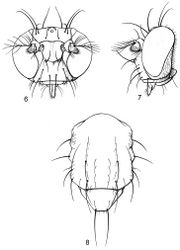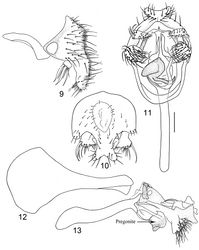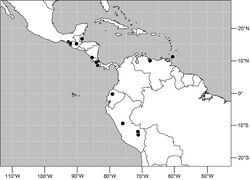Planinasus ambiguus
| Notice: | This page is derived from the original publication listed below, whose author(s) should always be credited. Further contributors may edit and improve the content of this page and, consequently, need to be credited as well (see page history). Any assessment of factual correctness requires a careful review of the original article as well as of subsequent contributions.
If you are uncertain whether your planned contribution is correct or not, we suggest that you use the associated discussion page instead of editing the page directly. This page should be cited as follows (rationale):
Citation formats to copy and paste
BibTeX: @article{Mathis2012ZooKeys225, RIS/ Endnote: TY - JOUR Wikipedia/ Citizendium: <ref name="Mathis2012ZooKeys225">{{Citation See also the citation download page at the journal. |
Ordo: Diptera
Familia: Periscelididae
Genus: Planinasus
Name
Planinasus ambiguus Cresson – Wikispecies link – Pensoft Profile
- Planinasus ambiguus Cresson 1914[1]: 246. Hennig 1969[2]: 615 [list, Peru]. Mathis and Rung 2011[3]: 363 [world catalog].
Description
Moderately small to medium-sized flies, body length 2.35–3.10 mm.
Head (Figs 6–7): Head ratio 0.66–0.73; frons mostly bare, shiny, except for densely microtomentose, velvety-appearing, anterolateral angles; frons wider than long, frontal ratio 0.47-0.51; interfrontal seta short, about 1/2 length of lateral vertical seta. Antenna unicolorous, blackish brown; pedicel with ventral projection short, not extended anteriorly much beyond dorsal margin; basal flagellomere short, height about 2/3 length; arista bearing 8-9 dorsal rays, 3-4 ventral rays. Face comparatively narrow; facial ratio 0.33-0.39; dorsal half of face shield-like, mostly bare, roughly pentagonal, with yellowish to slightly bluish reflections; facial setae more or less in 2-3 transverse rows (usually 2), dorsal row with 4 setae: a medial pair of setae, these approximate, dorsoclinate, sometimes cruciate toward apices; next seta of dorsal row porrect to ventroclinate; middle row with 2 setae (if present), porrect to ventroclinate; ventral facial row with 4 ventroclinate setae. Clypeus and palpus blackish brown.
Thorax (Fig. 8): Generally dark brown but with some paler, mostly yellowish areas along margins of sclerites; mesonotum moderately invested with whitish gray microtomentum, appearing dull medially, becoming subshiny, less microtomentose laterally; postpronotum yellowish; area from postpronotum and through notopleuron mostly bare, shiny; anepisternum moderately invested with very fine microtomentum, mostly appearing dull, bearing 1 large seta at posterior margin; other pleural areas less densely invested. Wing very faintly infumate, without pattern. Coxae whitish yellow; femora whitish yellow basally, distal 1/2–1/3 dark brown; forefemur lacking a preapical annulus; basal 1/3 of tibiae dark brown, thereafter gradually becoming yellowish; tarsi yellowish, apical 2–3 tarsomeres darker; forefemur bearing 2 setae at apical 1/3 along posteroventral surface.
Abdomen: Uniformly blackish brown, mostly subshiny, moderately invested with microtomentum. Male abdomen: Tergites 1+2-6 well developed, lengths of tergites 3-6 subequal; sternite 4 deeply emarginate along posterior margin; sternite 5 with posterior margin moderately deeply emarginate; sternite 6 well sclerotized and developed with width twice length, posterior margin with narrow notch medially, thereafter laterally forming 2 bluntly rounded, wide lobes; sternite 7 narrow, forming an annulus with tergite 7. Male terminalia (Figs 9–13): Epandrium in lateral view (Fig. 9) approximately trapezoidal, dorsal margin truncate, straight, slightly more than half length of shallowly arched ventral margin, in posterior view as a broad, inverted U, cercal cavity oval; surstylus as long as epandrium, extended from ventromedial margin of epandrium in nearly vertical alignment with it, in lateral view (Fig. 9) thumb-like, apex bluntly rounded to truncate, in posterior view (Figs 10) fused medially then bifurcate apically, forming more or less an X, each digitiform, divergent process rounded, length slightly more than width, bearing marginal setulae; hypandrium in ventral view (Fig. 11) U-shaped with anterior portion of mostly uniform width; postgonite in ventral view (Fig. 11) convoluted, with robustly developed lobe expanded apically, clavate, bearing numerous setulae, especially apically, in lateral view (Fig. 13) lobe with greatly expanded apical portion, apex somewhat truncate, bearing more than 20 setulae; phallus large, in ventral view (Fig. 11) complex, mostly sclerotized; phallapodeme in lateral and ventral views (Figs 11, 13) elongate, tubular, sinuous, rounded apically; ejaculatory apodeme in lateral view (Fig. 12) large, about 1/4 longer than length of phallapodeme, apical half greatly expanded, fan-like, basal half narrow, stem-like but slightly expanded toward base.
Type material
The holotype male is labeled “Cachi C[osta] R[ica][,] 9 III 1910 [9 Mar 1910][,] P P Calvert/Valley of Rio Naranjo/HoloTYPE 6069 [pink]/475 ♂/TYPE No. 6064 [number written across right end of label] Planinasus AMBIGUUS E.T.Cresson,Jr. [pink; species name and number handwritten].” The holotype is double mounted (minuten pin in rectangular card block), is in moderately poor condition (wings glued together), and is deposited in the ANSP (6069).
Type locality
Costa Rica. Cartago: Cachí, Valley of Rio Naranjo (09°49.6'N, 83°48'W).
Other specimens examined
BELIZE. Stann Creek: Cockscomb Basin Wildlife Sanctuary (16°47'N, 88°30'W), 5-6 Apr 1993, W. N. Mathis (1♂, 1♀; USNM).
COSTA RICA. Cartago: La Suiza (9°51.5'N, 83°37.5'W), 24 Mar, P. Schild (1♂; USNM). Guanacaste: Pitilla (9 km S Santa Cecilia; 10°59.5'N, 85°25.8'W; 700 m), Mar 1991, 1994, C. Moraga, P. Ríos (1♂, 2♀; INBIO). Puntarenas: San Pedrillo (8°37.2'N, 83°44.1'W), 12–14 Aug 2001, D. and W.N. Mathis (1♀; USNM). San José: RioSParaíso (09°33.8'N, 84°7.4'W), 15–17 Feb 2003, W. N. Mathis (21♂, 7♀; USNM).
ECUADOR. Pichincha: Santo Domingo de los Colorados, Tinalandia (16 km SE; 0°15.9'S, 79°9.8'W; 680 m), 15–30 May 1975, S. Peck (1♀; CNC).
GUATEMALA. Alta Verapaz: Tamahú (15°18.6'N, 90°14.2'W), 25 May 1926, J. M. Aldrich (3♂, 4♀; USNM).
MEXICO. Chiapas: Union Juarez (3 km S; 15°02.8'N, 92°05.3'W), 23 Apr 1983, W. N. Mathis (4♂; USNM); Finca Prusia (33 km S Jaltenango; 15°49'N, 92°42'W; 1000 m), 12 May 1985, W. N. Mathis (1♂, 4♀; USNM); Huixtla (32–40.5 km NE; 15°26.3'N, 92°06.8'W), 3 Jun 1969, H. J. Teskey (2♂; CNC).
PERU. Huánuco: Las Palmas (1 km N; 09°26.4'S, 75°58'W), 8 Feb 1984, W. N. Mathis (1♂; USNM); Tingo Maria (6 km S; 09°22.7'S, 75°58.5'W), 8 Feb 1984, W. N. Mathis (1♂; USNM). Madre de Dios: Río Manu, Erika (near Salvación; 12°50.7'S, 71°23.3'W; 550 m), 5–6 Sep 1988, W. N. Mathis (15♂, 8♀; USNM); Río Manu, Pakitza (11°56.6'S, 71°16.9'W; 250 m), 9–23 Sep 1988, A. Freidberg, W. N. Mathis (2♀; USNM).
TRINIDAD and TOBAGO. Tobago. St. John: Charlottville (2 km S, water treatment plant; 11°19'N, 60°33'W), 10 Jun 1993, W. N. Mathis (1♂, 1♀; USNM); Parlatuvier (creek; 11°17.9'N, 60°35'W), 20 Apr 1994, W. N. Mathis (12♂, 10♀; USNM). St. Paul: Argyle Falls (11°15'N, 60°35'W), 21 Apr 1994, W. N. Mathis (1♂; USNM); Roxborough (6.5 km N; 11°17'N, 60°35'W), 14 Jun 1993, W. N. Mathis (1♂; USNM).
VENEZUELA. Aragua: H. Pittier Nacional Parque (6 km N Rancho Grande Biological Station; 10°21.2'N, 67°42.9'W; along stream), 28 Feb 1995, S. A. Marshall (1♂; DEBU); Portachuelo Pass (10°02.7'N, 67°33'W), 16 Aug 1967, R. W. Poole (1♂; USNM).
Distribution
(Fig. 14). Neotropical: Belize, Costa Rica (Cartago, Guanacaste, Puntarenas, San José), Ecuador (Pichincha), Guatemala, Mexico (Chiapas), Peru (Huánuco, Madre de Dios), Trinidad and Tobago, and Venezuela (Aragua).
Remarks
This widespread species was previously known only from Costa Rica and Peru (Hennig 1969[2]) and is here recorded from as far north as Chiapas, Mexico, and to the south as far as Peru (Madre de Dios). This species can be easily confounded with the other two species in the ambiguus group based on external characters, but characters of the male terminalia of Planinasus ambiguus unambiguously diagnose this species. See “Remarks” under Planinasus aenigmaticus sp. n. for further discussion.
Taxon Treatment
- Mathis, W; Rung, A; Kotrba, M; 2012: A revision of the genus Planinasus Cresson (Diptera, Periscelididae) ZooKeys, 225: 1-83. doi
Other References
- ↑ Cresson E (1914) Descriptions of new genera and species of the dipterous family Ephydridae. I. Entomological News 25: 241-250.
- ↑ 2.0 2.1 Hennig W (1969) Neue Gattungen und Arten der Acalyptratae. The Canadian Entomologist 101 (6): 589-633. doi: 10.4039/Ent101589-6
- ↑ Mathis W, Rung A (2011) A world catalog and conspectus on the family Periscelididae (Diptera: Schizophora). Pp. 341–377. In Brake I, Thompson, FC (Eds) Contributions to Systema Dipterorum (Insecta: Diptera). Myia 12, viii + 564 pp.
Images
|


